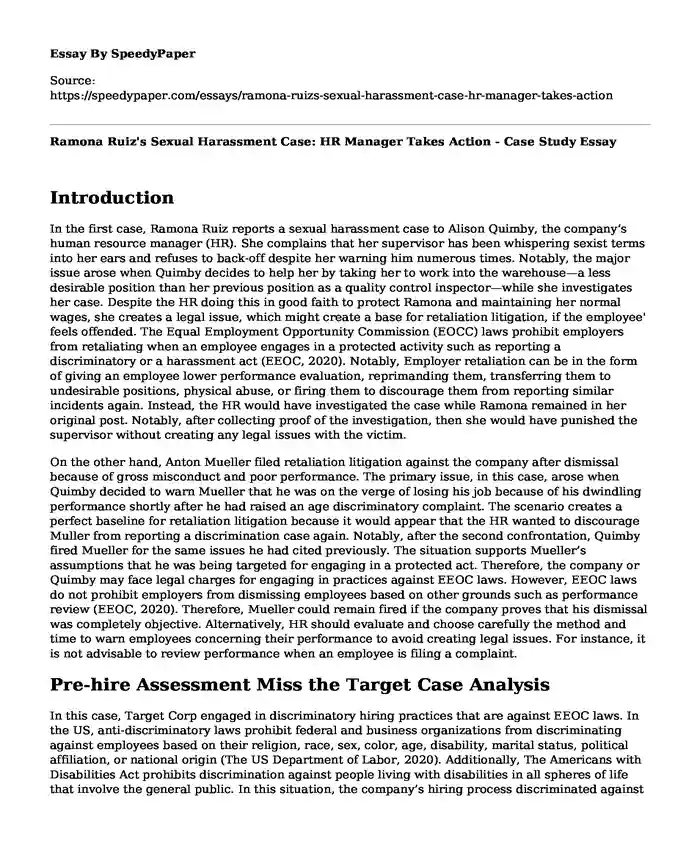
| Type of paper: | Case study |
| Categories: | Human resources Law Sexual assault Sexual abuse |
| Pages: | 3 |
| Wordcount: | 670 words |
Introduction
In the first case, Ramona Ruiz reports a sexual harassment case to Alison Quimby, the company’s human resource manager (HR). She complains that her supervisor has been whispering sexist terms into her ears and refuses to back-off despite her warning him numerous times. Notably, the major issue arose when Quimby decides to help her by taking her to work into the warehouse—a less desirable position than her previous position as a quality control inspector—while she investigates her case. Despite the HR doing this in good faith to protect Ramona and maintaining her normal wages, she creates a legal issue, which might create a base for retaliation litigation, if the employee' feels offended. The Equal Employment Opportunity Commission (EOCC) laws prohibit employers from retaliating when an employee engages in a protected activity such as reporting a discriminatory or a harassment act (EEOC, 2020). Notably, Employer retaliation can be in the form of giving an employee lower performance evaluation, reprimanding them, transferring them to undesirable positions, physical abuse, or firing them to discourage them from reporting similar incidents again. Instead, the HR would have investigated the case while Ramona remained in her original post. Notably, after collecting proof of the investigation, then she would have punished the supervisor without creating any legal issues with the victim.
On the other hand, Anton Mueller filed retaliation litigation against the company after dismissal because of gross misconduct and poor performance. The primary issue, in this case, arose when Quimby decided to warn Mueller that he was on the verge of losing his job because of his dwindling performance shortly after he had raised an age discriminatory complaint. The scenario creates a perfect baseline for retaliation litigation because it would appear that the HR wanted to discourage Muller from reporting a discrimination case again. Notably, after the second confrontation, Quimby fired Mueller for the same issues he had cited previously. The situation supports Mueller’s assumptions that he was being targeted for engaging in a protected act. Therefore, the company or Quimby may face legal charges for engaging in practices against EEOC laws. However, EEOC laws do not prohibit employers from dismissing employees based on other grounds such as performance review (EEOC, 2020). Therefore, Mueller could remain fired if the company proves that his dismissal was completely objective. Alternatively, HR should evaluate and choose carefully the method and time to warn employees concerning their performance to avoid creating legal issues. For instance, it is not advisable to review performance when an employee is filing a complaint.
Pre-hire Assessment Miss the Target Case Analysis
In this case, Target Corp engaged in discriminatory hiring practices that are against EEOC laws. In the US, anti-discriminatory laws prohibit federal and business organizations from discriminating against employees based on their religion, race, sex, color, age, disability, marital status, political affiliation, or national origin (The US Department of Labor, 2020). Additionally, The Americans with Disabilities Act prohibits discrimination against people living with disabilities in all spheres of life that involve the general public. In this situation, the company’s hiring process discriminated against black, Asian, and female candidates and also subjected the applicants to a psychological test that would have discriminated against people living with mental disabilities (The US Department of Labor, 2020).
Alternatively, the company would have used a more objective process where, bias based on gender, race, and color would not have been tolerated. All hiring processes should free of discrimination to provide every candidate equal opportunity. In the case the company prefers a specific demographic, they should make it known in the job vacancy announcement. Additionally, the company should evaluate all recruitment assessments to ensure that they do not create legal problems such as discrimination of persons living with cognitive disabilities.
References
EEOC. (2020). Retaliation – making it personal. US Equal Employment Opportunity Commission. Retrieved from https://www.eeoc.gov/retaliation-making-it-personal
The US Department of Labor. (2020). Americans with Disability Act. The US Department of Labor. Retrieved from https://www.dol.gov/general/topic/disability/ada
Cite this page
Ramona Ruiz's Sexual Harassment Case: HR Manager Takes Action - Case Study. (2023, Nov 25). Retrieved from https://speedypaper.net/essays/ramona-ruizs-sexual-harassment-case-hr-manager-takes-action
Request Removal
If you are the original author of this essay and no longer wish to have it published on the SpeedyPaper website, please click below to request its removal:
- Utilizing Employee Survey Data, Free Essay in HRM
- Essay Sample Dedicated to the Human Resource Policies of the ICRC
- Community Policing Essay Example
- Employee Health and Safety. Paper Example
- Free Essay - Reduction of Illegal Drugs in Transit to the US
- Essay Example - The Seizure of Electronic Evidence
- Regulations of Requirement on Human Resource Processes - Free Paper Sample
Popular categories




